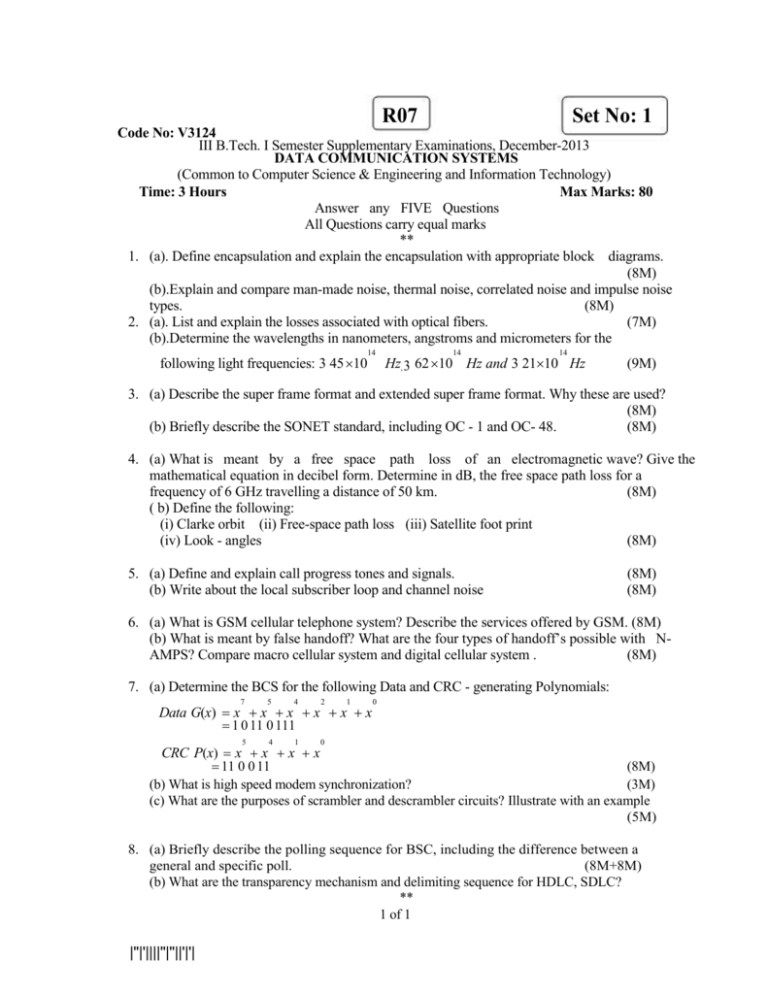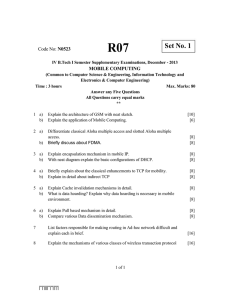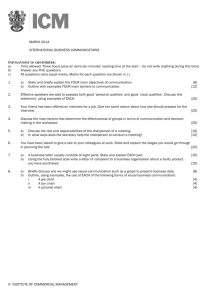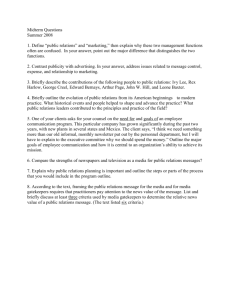2013S
advertisement

R07 Set No: 1 Code No: V3124 III B.Tech. I Semester Supplementary Examinations, December-2013 DATA COMMUNICATION SYSTEMS (Common to Computer Science & Engineering and Information Technology) Time: 3 Hours Max Marks: 80 Answer any FIVE Questions All Questions carry equal marks ** 1. (a). Define encapsulation and explain the encapsulation with appropriate block diagrams. (8M) (b).Explain and compare man-made noise, thermal noise, correlated noise and impulse noise types. (8M) 2. (a). List and explain the losses associated with optical fibers. (7M) (b).Determine the wavelengths in nanometers, angstroms and micrometers for the following light frequencies: 3 45 10 14 14 14 Hz, 3 62 10 Hz and 3 2110 Hz (9M) 3. (a) Describe the super frame format and extended super frame format. Why these are used? (8M) (b) Briefly describe the SONET standard, including OC - 1 and OC- 48. (8M) 4. (a) What is meant by a free space path loss of an electromagnetic wave? Give the mathematical equation in decibel form. Determine in dB, the free space path loss for a frequency of 6 GHz travelling a distance of 50 km. (8M) ( b) Define the following: (i) Clarke orbit (ii) Free-space path loss (iii) Satellite foot print (iv) Look - angles (8M) 5. (a) Define and explain call progress tones and signals. (b) Write about the local subscriber loop and channel noise (8M) (8M) 6. (a) What is GSM cellular telephone system? Describe the services offered by GSM. (8M) (b) What is meant by false handoff? What are the four types of handoff’s possible with NAMPS? Compare macro cellular system and digital cellular system . (8M) 7. (a) Determine the BCS for the following Data and CRC - generating Polynomials: 7 5 4 2 5 4 1 0 1 Data G(x) x x x x x x 1 0 11 0 111 0 CRC P(x) x x x x 11 0 0 11 (8M) (b) What is high speed modem synchronization? (3M) (c) What are the purposes of scrambler and descrambler circuits? Illustrate with an example (5M) 8. (a) Briefly describe the polling sequence for BSC, including the difference between a general and specific poll. (8M+8M) (b) What are the transparency mechanism and delimiting sequence for HDLC, SDLC? ** 1 of 1 |''|'||||''|''||'|'| Code No: V3124 R07 Set No: 2 III B.Tech. I Semester Supplementary Examinations, December-2013 DATA COMMUNICATION SYSTEMS (Common to Computer Science & Engineering and Information Technology) Time: 3 Hours Max Marks: 80 Answer any FIVE Questions All Questions carry equal marks ** 1. a) Define the following terms: data, information, data communication network and Protocol. Explain the relationship between network architecture and protocol. b) What are the difference between peer to peer client/server networks and dedicated client/server networks? 2. a) Explain the following terms: velocity of propagation, refraction and refractive index. b) Explain about step index fiber cable and graded index cable. And also contrast the advantages and disadvantages of step index, graded index, single mode and multi mode propagation. 3. a) What are the four most common methods of pulse modulation? Explain. b) Define companding? Briefly explain the process of digital commanding. 4. a) Describe a high/low microwave systems? b) How many satellite transponders are required to interlink six earth stations with FDM/FM modulation? Explain in detail. 5. a) What considerations are addressed by the interface parameters and facility parameters? b) Describe what is meant by a two-wire circuit and a four wire circuit. 6. a) Draw and explain voice channel format. Explain each block. b) Mention the difference between FDMA, TDMA and CDMA. c) What is the difference between wire line and non-wire line company? 7. a) How many hamming bits ate required for a single EBCDIC character? b) Briefly describe the following data communication codes Baudot, ASCII and EBCDIC? 8. a) What is the difference between character and bit oriented protocol? b) Describe the difference between asynchronous and synchronous protocol? c) Discuss invert-on-zero encoding. ** 1 of 1 |''|'||||''|''||'|'| Code No: V3124 R07 Set No: 3 III B.Tech. I Semester Supplementary Examinations, December-2013 DATA COMMUNICATION SYSTEMS (Common to Computer Science & Engineering and Information Technology) Time: 3 Hours Max Marks: 80 Answer any FIVE Questions All Questions carry equal marks ** 1. a) List and briefly describe the five basic data communication networks topology. b) List and briefly describe the major network classifications. c) Briefly describe the TCP/IP protocol model. 2. a) Explain the operation of light emitting diode. What are the primary types of LEDs? What is lasing? Describe the operation of an injection laser? b) Determine the light frequencies for the following wavelength. i) 650nm ii) 7200 Ao iii) 690 nm 3. a) What is the difference between WDM and DWDM? List the advantages and disadvantages of WDM? Give brief discussion on WDM circuit components. b) Define multiplexing? Draw the block diagram of TDM and explain in detail? What is the purpose of the signaling bit? 4. a) What is a common signaling channel and how it is used? b) Discuss the drawbacks of using FDM/FM modulation for satellite multiple accessing Systems. 5. a) Briefly explain local subscriber loop. b) Frequency of 250 HZ and 1 KHZ are applied to the input of a C-message filter would their difference in amplitude be (greater, the same or less) at the output of the filter? 6. a) What is the difference between personal communication network and personal communication services? b) Briefly describe the functions home location register and visitor location registers. 7. a) Describe what is meant by error control? Explain the difference between error detection and error correction. b) Describe data communication modems and explain where there are used in data communication circuits. 8. a) Determine the Hexa code for the control field in an SDLC frame for the following conditions: supervisory frame, ready to receive, final and confirming reception of frames 6, 7 and 0? b) What are five fields used with SDLC? Explain? ** 1 of 1 |''|'||||''|''||'|'| Code No: V3124 R07 Set No: 4 III B.Tech. I Semester Supplementary Examinations, December-2013 DATA COMMUNICATION SYSTEMS (Common to Computer Science & Engineering and Information Technology) Time: 3 Hours Max Marks: 80 Answer any FIVE Questions All Questions carry equal marks ** 1. a) Briefly describe the seven layers of the OSI protocol hierarchy. b) List and briefly describe the four transmission modes. 2. a) Describe the characteristics of electromagnetic waves. b) What are the differences between transmission line and metallic transmission line? Explain with neat circuits. 3. a) Describe FDM? What is the difference between FDM and TDM? b) What is codec and combo chip? What is a fixed data rate mode? And explain. 4. Define and explain the following terms: (i) Electromagnetic polarization (ii) Electromagnetic radiation (iii) Skip distance 5. a) What is the purpose of an echo suppressor and an echo canceller.? b) What is the difference between TLP and DLP? c) What is the difference between DB and DBM? 6. a) Briefly explain GSM cellular telephone system? Outline the services offered by GSM and describe GSM architecture. b) List the IS-95 specifications. 7. a) What is the difference between asynchronous and synchronous modems? Describe modem equalization? b) Briefly describe the following ITU-T modem recommendations: v.29, v.32, v.32 bis, v.32 fast, v.42 bis, v.42, v.33 and v. 34+ 8. a) Sketch the NRZI levels for the following data stream (start with high condition) 11010001101 b) Discuss high level data link control. ** 1 of 1 |''|'||||''|''||'|'|







